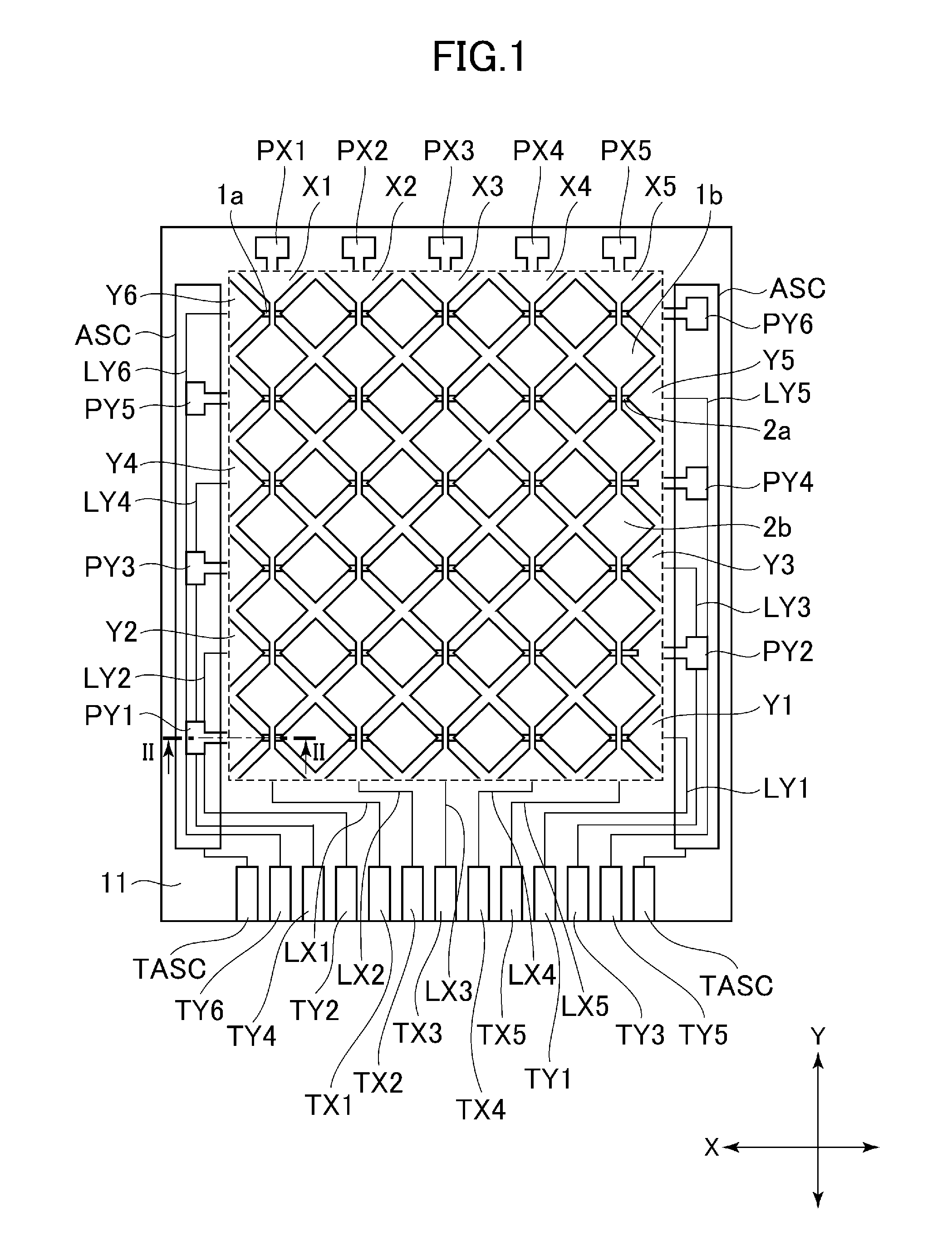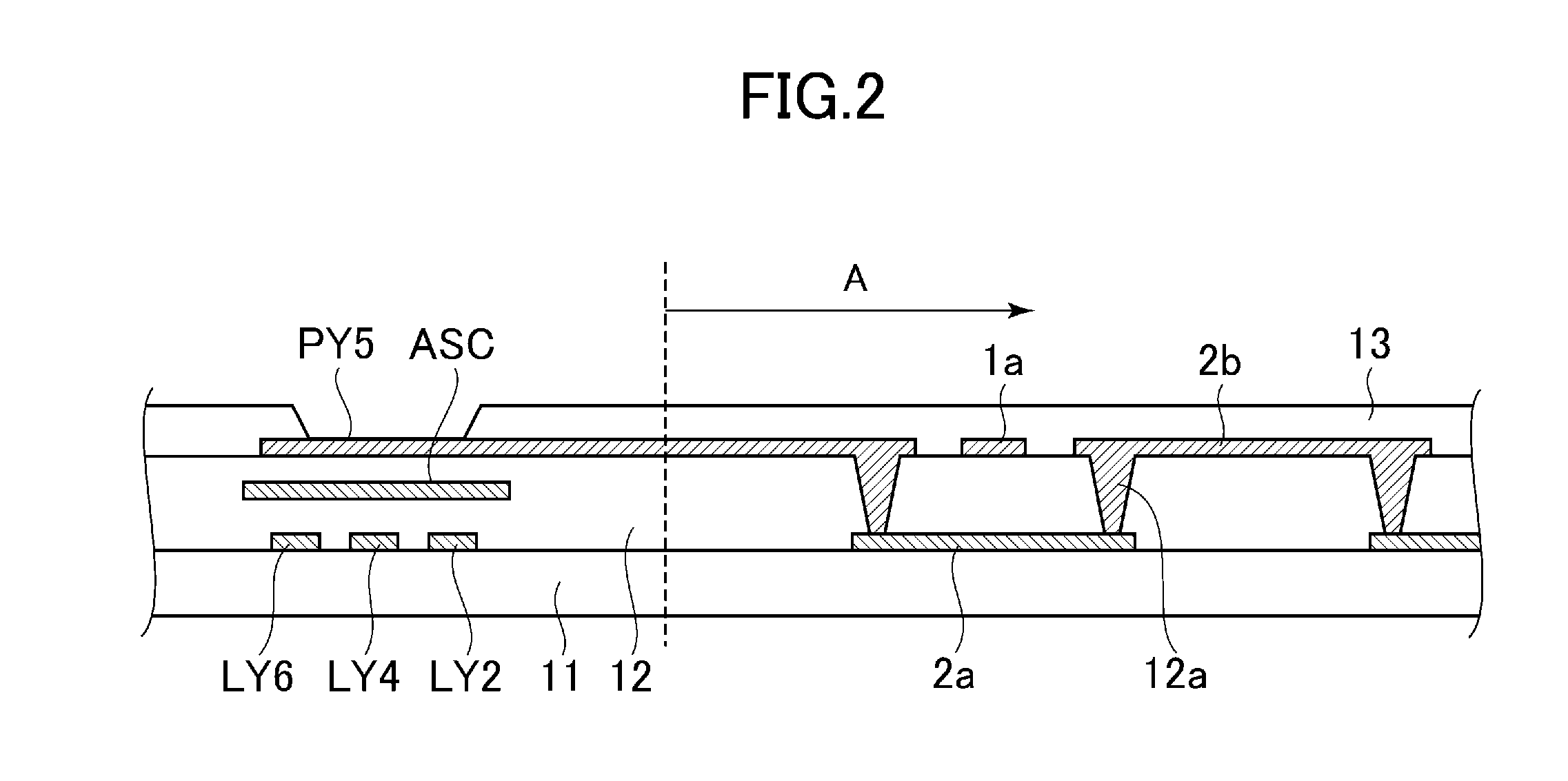Touch panel and display device
a display device and touch panel technology, applied in the field of touch panel and display device, can solve the problems of inability to inspect the lead line of the y electrode or the disconnection of the y electrode, and achieve the effect of narrowing the width of the picture frame outside the effective touch region
- Summary
- Abstract
- Description
- Claims
- Application Information
AI Technical Summary
Benefits of technology
Problems solved by technology
Method used
Image
Examples
embodiment 1
[0034]FIG. 1 is a view for explaining a touch panel according to the embodiment 1 of the present invention, and FIG. 2 is a cross-sectional view of an essential part showing the cross-sectional structure of the touch panel taken along a line II-II in FIG. 1.
[0035]As shown in FIG. 1, the touch panel of this embodiment includes a plurality of X electrodes (X1 to X5) which extend in a second direction (Y direction) and are arranged parallel to each other in a first direction (X direction) which intersects with the second direction at a predetermined arrangement pitch, and a plurality of Y electrodes (Y1 to Y6) which extend in the first direction intersecting with the X electrodes and are arranged parallel to each other in the second direction at a predetermined arrangement pitch. A portion indicated by a dotted frame in FIG. 1 indicates an effective touch region.
[0036]Each one of the plurality of X electrodes has an electrode pattern in which a fine line portion 1a and a pad portion 1b...
embodiment 2
[0065]FIG. 3 is a view for explaining a touch panel according to an embodiment 2 of the present invention, and FIG. 4 is a cross-sectional view of an essential part showing the cross-sectional structure of the touch panel taken along a line IV-IV in FIG. 3.
[0066]This embodiment is characterized in that inspection pads (PY1 to PY6) are formed outside terminal portions (TX1 to TX5, TY1 to TY6) formed on one side of a substrate where the terminal portions are formed, and inspection-use lead lines (LPY1 to LPY6) are connected between the inspection pads (PY1 to PY6) and the other end portions of Y electrodes.
[0067]The inspection-use lead lines (LPY1 to LPY6) are formed over the same layer over which fine line portions 1a and pad portions 1b of X electrodes and pad portions 2b of the Y electrodes are formed, and the inspection-use lead lines (LPY1 to LPY6) are formed of a transparent conductive film made of ITO or the like in the same manner as the X electrodes and the Y electrodes. Due ...
embodiment 3
[0079]FIG. 8 is a view for explaining an X electrode of a touch panel according to an embodiment 3 of the present invention. This electrostatic-capacitance type touch panel determines presence or non-presence of a finger touch based on a change in capacitance of the X electrode or a Y electrode in response to the finger touch. Sensitivity in such an operation is influenced by capacitances and resistances of the X electrode and the Y electrode per se. That is, when the capacitances are large, it is impossible to grasp the change in capacitance when a user touches the touch panel. When the resistances are large, the electrodes (X electrode and Y electrode) cannot be charged sufficiently and hence, a response value for the finger touch becomes small so that sensitivity is lowered.
[0080]Further, when the reaction value in response to the finger touch fluctuates within an effective touch region, a region where sensitivity is insufficient is formed partially and such a region adversely in...
PUM
 Login to View More
Login to View More Abstract
Description
Claims
Application Information
 Login to View More
Login to View More - R&D
- Intellectual Property
- Life Sciences
- Materials
- Tech Scout
- Unparalleled Data Quality
- Higher Quality Content
- 60% Fewer Hallucinations
Browse by: Latest US Patents, China's latest patents, Technical Efficacy Thesaurus, Application Domain, Technology Topic, Popular Technical Reports.
© 2025 PatSnap. All rights reserved.Legal|Privacy policy|Modern Slavery Act Transparency Statement|Sitemap|About US| Contact US: help@patsnap.com



